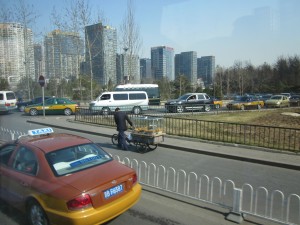I have only been in Shanghai for a couple of hours–mostly in my hotel room. But it is HUGE. Our bus ride from the airport took about forty-five minutes and you could probably lose Seattle ten times–easily. High-rises stretch forever in every direction. If there is an end to them, I haven’t spotted it yet. And many are brightly lit.
We began the day with an invigorating briefing at the US Embassy in Beijing. Rosemary Gallant and several other embassy staff were great in putting what we were seeing in context. As it is 11 p.m. here and I have to be up 530 a.m., I will summarize some of what we discussed in bullet points. Some of this stuff is really thought provoking:
- The rate of growth of the economy is down to 7.2–7.5 percent. That is causing some concerns in China. People expect more. The government is also concerned about inflation.
- The US trade deficit is around $300 billion, but exports are up.
- There are more than $500 million netizens in China.
- There are 356 million mobile phone users–but the numbers could be twice as big.
- Domestic consumption is 35%–very low compared to other world economies (the US is 70%).
- The national savings rate for individuals is 40%–but for people under 30 years old it is essentially zero.
- There are 171 cities in China with a population of one million or more.
 Chinese economic demands are forcing the nation to be more foreign policy oriented. Chinese nationals living outside of the country are also of concern and are requiring governmental attention (in Libya, for example).
Chinese economic demands are forcing the nation to be more foreign policy oriented. Chinese nationals living outside of the country are also of concern and are requiring governmental attention (in Libya, for example). - The party has great concern about increasing social disparities, particularly in housing, health care, and education.
- The Party Congress will be held this fall and new leadership will be selected. There is debate about the future direction of the nation–some believe that more government control of the economy is needed; others believe that increased public participation will result in more sustainable growth. Complicating this are groups of entrenched interests, who are reluctant to support alteration of a system that has brought them great benefit.
- Some Party members are concerned enough to worry about the survival of the Party over the next ten years, if these issues are not addressed.
- “The Party always works on consensus.”
- Seventy percent of health care dollars are paid out of pocket.
- The twelfth five year has big cleantech and environmental goals. These are real governmental objectives for which strong efforts will be made to accomplish them.
 We went on to a briefing by Dr. Wang Jinzhao at the China Development Research Council. Dr. Wang told us about the Five Year Plan and low carbon development. He noted that China imports about half of its oil today and expectations are that it could increase to 70% by 2020. The nation has ambitious plans to develop wind and solar energy. Building efficiency will play a large role. There is a goal to put one million electric vehicles on the road by 2015. Carbon trading plans are being considered. It is unclear at this point what role natural gas will play in China’s energy future. There are efforts to increase gas utilization from 3 percent to more than double that amount. At this point, it is unknown what kind of usable reserves might be exploited from fracking.
We went on to a briefing by Dr. Wang Jinzhao at the China Development Research Council. Dr. Wang told us about the Five Year Plan and low carbon development. He noted that China imports about half of its oil today and expectations are that it could increase to 70% by 2020. The nation has ambitious plans to develop wind and solar energy. Building efficiency will play a large role. There is a goal to put one million electric vehicles on the road by 2015. Carbon trading plans are being considered. It is unclear at this point what role natural gas will play in China’s energy future. There are efforts to increase gas utilization from 3 percent to more than double that amount. At this point, it is unknown what kind of usable reserves might be exploited from fracking.
Following lunch, we began our journey to Shanghai–which took forever. There was a long wait and delay in the Beijing airport and we got in late. Now to bed….
